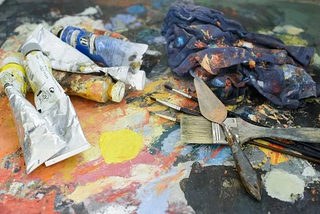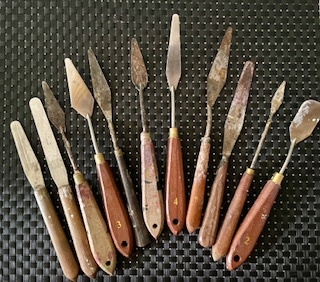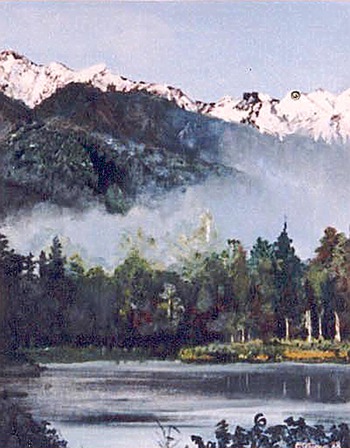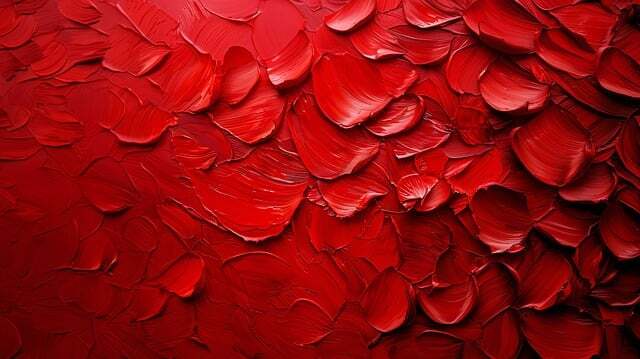How to Achieve Stunning Results with Palette Knives
Using a palette knife in oil and acrylic painting can add texture, boldness, and expressiveness to your artwork. Because there are various types of palette knives available, I'm going to explain what they are and how to use them.
Each palette knife is designed for specific effects, and understanding their unique differences is the key to mastering their use. I enjoy the freedom and difference of using a palette knife in my art as a New Zealand artist at times, the abilty to smear paint across a canvas in onn thick quick coat is empowering.
Types of Palette Knives and Their Uses
Straight Edge Palette Knife:
Shape: Long, straight blade with a flat surface.
Use: This type of palette knife is ideal for creating smooth, broad strokes of colour. It allows you to spread the paint evenly over large areas, which is perfect for backgrounds or blending. You can also use the edge to create sharp lines and define geometric shapes.
Offset/Angled Palette Knife:
Shape: A blade that is offset from the handle, usually with a slight bend.
Use: This palette knife design helps to keep your hands clean and away from the wet paint. It's perfect for applying thick layers of paint and creating ridges or peaks, often used in impasto techniques.
The ergonomic type angle offers excellent control for sweeping motions and layering colours without muddying them.
Pointed Tip Palette Knife:
Shape: A narrow blade with a pointed tip.
Use: Great for detailed work and precision, this type of palette knife helps create thin lines, small textures, or more intricate shapes. The pointed tip can be used to scratch into wet paint for sgraffito effects, a technique I like to use, revealing the layers beneath.
Diamond Shaped Palette Knife:
Shape: A diamond-shaped blade with a slightly flexible body.
Use: This type of palette knife offers a lot of moreversatility for creating both smooth and textured strokes. The sharper edges are useful for creating fine lines, while the broad flat area can be used for mixing or spreading the paint across larger sections. Due to its adaptability, it's often favoured for abstract work.
Rounded or Oval Palette Knife:
Shape: Curved or oval blade with a rounded tip.
Use: This type of palette knife is excellent for atmospheric effects, like painting skies, clouds or water. It helps blend the colours smoothly, create soft transitions, or apply paint in a circular, cloud-like manner. It's also great for soft, flowing applications.
Short Blade Knife:
Shape: Short, stiff blade.
Use: Perfect for controlled, small-area applications. It's often used to add highlights and small details or create textures in confined spaces.

Tips for Using Palette Knives
- Mixing Paint: Palette knives are excellent tools for mixing paints on your palette. Their flat surface ensures thorough mixing without trapping pigment, which can happen with brushes.
- Impasto Technique: When using thicker paints like oil or heavy-body acrylics, the palette knife shines in creating impasto effects. Apply thick layers of paint, building texture that stands off the canvas, catching light for dynamic, tactile artwork.
- Sgraffito: This technique involves scratching into wet paint with the knife's edge or tip to reveal layers beneath, adding contrast and depth to your work.
- Clean Lines and Edges: Depending on the amount of pressure you apply, palette knives can create sharp, defined edges or blend them into softer, less structured forms. Experiment with varying pressure to see how it influences your stroke.
- Control and Texture: The amount of pressure you apply with a palette knife directly affects the texture and coverage of the paint. A light touch will apply a thin layer, while a heavy stroke will leave thick, textured ridges.
Selection of palette knives
Canvas Care: Protecting Your Work While Using Palette Knives
When working with palette knives, it's important to take care of your canvas to maintain the integrity of your painting. Here are a few considerations to keep in mind:
Avoid Damaging the Canvas:
While palette knives are excellent tools for creating texture and applying thick layers of paint, they are also made of metal. If you're not careful, they can easily damage the canvas. The edge or tip of the knife can gouge the canvas if pressed too hard, leaving unwanted marks or even tearing the surface.
Always be mindful of the amount of pressure you apply, especially when using the knife to scrape or manipulate paint in detailed areas.
Building Layers Thoughtfully:
One of the pleasures of working with palette knives is the ability to build up thick, textured layers of paint. However, it's essential to avoid adding too many layers at once. Overloading the canvas with thick paint applications can result in muddied colours, especially when working with complementary colours like red and green or blue and orange.
When mixed too much, these colours can neutralise each other, leading to dull, brownish hues. To avoid this, let each layer dry slightly before applying more paint, especially if you want to maintain the vibrancy and distinction between colours. Oil paints, in particular, take much longer to dry in thicker areas, so patience is vital.
Drying Times and Texture:
Large lumps of paint created with palette knives take significantly longer to dry compared to thinner applications. This extended drying time gives you the chance to adjust and work with the texture, but it also means you should plan your layering strategy carefully.
If you're working on a textured piece, consider letting the underlying layers set for a while before adding new ones to avoid unintentionally blending too much or flattening the existing textures.
Keep Your Palette Knife Clean:
It's easy for colours to mix unintentionally when using a palette knife, especially when working with large swathes of paint. Cleaning your knife regularly throughout the painting process helps you avoid accidental colour mixing.
Wiping your knife with a cloth or paper towel after every few strokes will keep your colours fresh and distinct, allowing you to maintain better control over the palette. This is especially crucial when switching between contrasting or highly pigmented shades, where a small amount of residue can dramatically affect the tone of your next stroke.
By following these guidelines, you'll ensure that your palette knife work remains intentional and clean, resulting in a more polished and professional finish to your artwork.
Proper care of both the knife and the canvas will allow you to explore more complex textures and layering techniques without compromising the quality of your piece.

Practice Makes Perfect!
Now that you have an understanding of the basics of using a palette knife, the next step is to practice and refine your skills. Like any technique, working with a palette knife takes time, experimentation, and repetition to truly master.The more you practice, the more confident and intuitive your knife work will become.
Palette knives offer a freedom and expressiveness that brushes can't always achieve, and the possibilities are endless. So, don't be afraid to push the boundaries of what you've learned—try different mixing methods, explore various ways to apply paint, and experiment with textures.
Each stroke is an opportunity to discover something new, whether it's a bold new texture or an unexpected colour combination.
Southern Alps painting with palette knife work on the mountain peaks
Ideas for Your First Palette Knife Paintings
If you're wondering where to start, here are a few common subjects that lend themselves well to palette knife painting. Each suggestion will allow you to explore different techniques and approaches:
Snow on Mountain Peaks:
Use the edge of a straight or angled knife to create the sharp, jagged lines of mountain ridges. For snow, apply lighter colours like white or pale blues in thick, textured strokes to build a natural, windswept look on the peaks.
This technique creates depth and contrast between the snowy areas and the rock beneath.
Reflected Light on Surfaces:
Palette knives are perfect for mimicking how light plays off different surfaces like rocks, water, or wood. By gently dragging the flat side of the knife over wet paint, you can create the illusion of reflective highlights.
This technique is particularly effective in landscape painting, where reflective water or sunlit rocks are common features.
Details of Leaves and Tree Bark:
Use a pointed or short blade knife to add fine details to foliage or bark for a more natural and organic texture. The knife allows for varied pressure, enabling you to create delicate leaf patterns and tree bark's rough, cracked texture.
Experiment with layering to build depth and complexity, giving the foliage or bark a more lifelike appearance.
Abstract Representations of Natural Objects:
Whether you're painting rocks, grass, shrubs, or any other natural objects, palette knives are an ideal tool for abstract interpretations. Use broad, sweeping motions to create the general form of rocks or shrubs, then go back with the knife's edge to carve in finer details.
The flexibility of a palette knife lets you keep things loose and expressive while still maintaining a recognisable shape.
Wispy Clouds:
To capture the softness and fluidity of clouds, a rounded or oval knife can be used to blend and spread light colours like whites, pinks, or soft blues. By gently swirling the knife in circular motions, you can create the illusion of soft, wispy clouds drifting across the sky.
This technique also allows you to blend seamlessly into the background, creating a dreamy, atmospheric effect.
Explore Beyond the Basics
These ideas are just the beginning. As you become more comfortable with your palette knife, you'll find that you can create an almost limitless range of textures and effects, from bold, impasto strokes to delicate, fine details.
Try painting textured seas, textured fabrics in still lifes, or even cityscapes with rugged architectural strokes. The key is to keep experimenting; don't limit yourself to traditional subjects. Abstract work, for instance, is particularly suited to palette knife techniques, where texture and colour are often more important than precise forms.
With practice, you'll not only improve your technical skills but also develop your own unique style of palette knife painting. Whether you're looking to add rich textures to your landscape work or to push the boundaries of abstract art, the palette knife is a versatile and powerful tool in your artistic arsenal.
Posted: Sunday 6 October 2024



